楔子
在讲新知识之前,我们先来复习复习函数的基础知识。
问:函数怎么调用?
函数名()
如果你们这么说。。。那你们就对了!好了记住这个事儿别给忘记了,咱们继续谈下一话题。。。
来你们在自己的环境里打印一下自己的名字。
你们是怎么打的呀?
是不是print(‘xxx‘),好了,现在你们结合我刚刚说的函数的调用方法,你有没有什么发现?
我们就猜,print有没有可能是一个函数?
但是没有人实现它啊。。。它怎么就能用了呢?
早在我们“初识函数”的时候是不是就是用len()引出的?
那现在我们也知道len()也是一个函数,也没人实现,它好像就自己能用了。。。
之前老师给你讲你可以这样用你就用了,那你有没有想过像这样直接拿来就能用的函数到底有多少?
内置函数
接下来,我们就一起来看看python里的内置函数。截止到python版本3.6.2,现在python一共为我们提供了68个内置函数。它们就是python提供给你直接可以拿来使用的所有函数。这些函数有些我们已经用过了,有些我们还没用到过,还有一些是被封印了,必须等我们学了新知识才能解开封印的。那今天我们就一起来认识一下python的内置函数。这么多函数,我们该从何学起呢?
上面就是内置函数的表,68个函数都在这儿了。这个表的顺序是按照首字母的排列顺序来的,你会发现都混乱的堆在一起。比如,oct和bin和hex都是做进制换算的,但是却被写在了三个地方。。。这样非常不利于大家归纳和学习。那我把这些函数分成了6大类。你看下面这张图,你猜咱们今天会学哪几大类呀?

我猜你们都猜对了。我们今天就要学习用粉红色标注出来的这四大块——56个方法。还有12个方法欠着怎么办呢?我们讲完面向对象这剩下的12个会在两周之内陆续还给你们的,我保证(认真脸)。那这样,我们今天就主要关注我们要学习的这56个方法。
那要学的一共4块,咱们从哪儿开始学起呢?
作用域相关
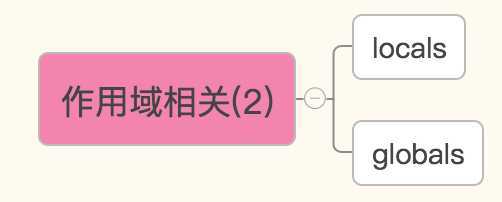
基于字典的形式获取局部变量和全局变量
globals()——获取全局变量的字典
locals()——获取执行本方法所在命名空间内的局部变量的字典
注意:与global和 nonlocal 不一样
global 是定义全局变量的关键字
nonlocal 是定义局部或与之相连的上一级的变量关键字
其他
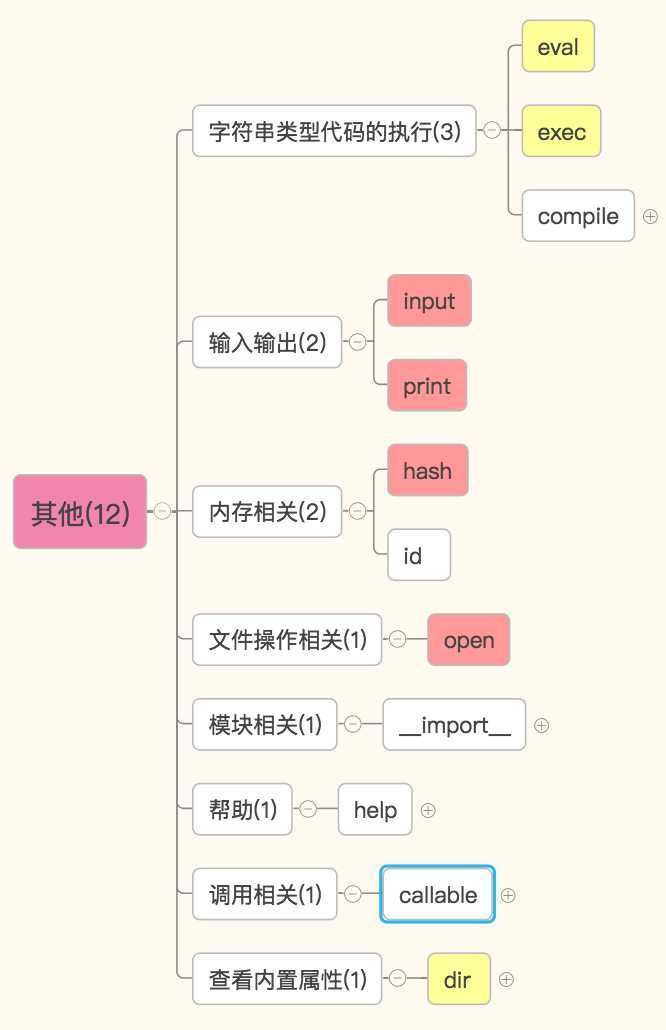
字符串类型代码的执行
内置函数——eval、exec、compile
eval() 将字符串类型的代码执行并返回结果
eval(‘print(1,23)‘)
# 1 23
exec()将自字符串类型的代码执行
print(exec("1+2+3+4"))
结果:None
exec("print(‘hello,world‘)")
结果:hello,world
指定blobal参数
code = ‘‘‘
import os
print(os.path.abspath(‘.‘))
‘‘‘
code = ‘‘‘
print(123)
a = 20
print(a)
‘‘‘
a = 10
exec(code,{‘print‘:print},)
print(a)
参数说明:
1. 参数source:字符串或者AST(Abstract Syntax Trees)对象。即需要动态执行的代码段。
2. 参数 filename:代码文件名称,如果不是从文件读取代码则传递一些可辨认的值。当传入了source参数时,filename参数传入空字符即可。
3. 参数model:指定编译代码的种类,可以指定为 ‘exec’,’eval’,’single’。当source中包含流程语句时,model应指定为‘exec’;当source中只包含一个简单的求值表达式,model应指定为‘eval’;当source中包含了交互式命令语句,model应指定为‘single‘。
#流程语句使用exec
code1 = ‘for i in range(0,10): print (i)‘
compile1 = compile(code1,‘‘,‘exec‘)
exec (compile1)
>>> #简单求值表达式用eval >>> code2 = ‘1 + 2 + 3 + 4‘
>>> compile2 = compile(code2,‘‘,‘eval‘)
>>> eval(compile2)
>>> #交互语句用single
>>> code3 = ‘name = input("please input your name:")‘
>>> compile3 = compile(code3,‘‘,‘single‘)
>>> name #执行前name变量不存在
Traceback (most recent call last):
File "<pyshell#29>", line 1, in <module>
name
NameError: name ‘name‘ is not defined
>>> exec(compile3) #执行时显示交互命令,提示输入
please input your name:‘pythoner‘
>>> name #执行后name变量有值
"‘pythoner‘"
# exec 和eval 都可以执行字符串类型的代码
# eval和返回值--有结果的简单计算
# exec 没有返回值---简单流程控制
# eval 只能用在你明确知道你要执行的代码是什么
输入输出相关:
input() 输入
s = input("请输入内容 : ") #输入的内容赋值给s变量
print(s) #输入什么打印什么。数据类型是str
print() 输出
def print(self, *args, sep=‘ ‘, end=‘\n‘, file=None): # known special case of print
"""
print(value, ..., sep=‘ ‘, end=‘\n‘, file=sys.stdout, flush=False)
file: 默认是输出到屏幕,如果设置为文件句柄,输出到文件
sep: 打印多个值之间的分隔符,默认为空格
end: 每一次打印的结尾,默认为换行符
flush: 立即把内容输出到流文件,不作缓存
"""
print(‘我们的祖国是花园‘,sep=‘‘) #指定输出的结束符
# 结果为:
# 我们的祖国是花园
# Process finished with exit code 0
# 如不指定,输出的结果为:
我们的祖国是花园
Process finished with exit code 0
print(1,2,3,sep=‘|‘) #指定输出多个值之间的分隔符
f = open(‘file‘,‘w‘)
print(‘aaaa‘,file=f) #打印aaaa到file文件中
file关键字说明
f = open(‘tmp_file‘,‘w‘)
print(123,456,sep=‘,‘,file = f,flush=True)
打印进度条
import time
for i in range(0,101,2):
time.sleep(0.1)
char_num = i//2 #打印多少个‘*‘
per_str = ‘\r%s%% : %s\n‘ % (i, ‘*‘ * char_num) if i == 100 else ‘\r%s%% : %s‘%(i,‘*‘*char_num)
print(per_str,end=‘‘, flush=True)
#小越越 : \r 可以把光标移动到行首但不换行
数据类型相关:
type(o) 返回变量o的数据类型
内存相关:
id(o) o是参数,返回一个变量的内存地址
hash(o) o是参数,返回一个可hash变量的哈希值,不可hash的变量被hash之后会报错。
hash值实例
t = (1, 2, 3)
l = [1, 2, 3]
print(hash(t)) #可hash
结果:-2022708474
# print(hash(l)) #会报错
‘‘‘
结果:
TypeError: unhashable type: ‘list‘
‘‘‘
hash函数会根据一个内部的算法对当前可hash变量进行处理,返回一个int数字。
每一次执行程序,内容相同的变量hash值在这一次执行过程中不会发生改变。
文件操作相关
open() 打开一个文件,返回一个文件操作符(文件句柄)
操作文件的模式有r,w,a,r+,w+,a+ 共6种,每一种方式都可以用二进制的形式操作(rb,wb,ab,rb+,wb+,ab+)
可以用encoding指定编码.
f.writable 检测是否可以写
f.readable 检测是否可以读
模块操作相关
__import__导入一个模块
导入模块
import time
也可以以下这中模式打开
os = __import__(‘os‘)
print(os.path.abspath(‘.‘))
帮助方法
在控制台执行help()进入帮助模式。可以随意输入变量或者变量的类型。输入q退出
或者直接执行help(o),o是参数,查看和变量o有关的操作。。。
和调用相关
callable(o),o是参数,看这个变量是不是可调用。
如果o是一个函数名,就会返回True
callable实例
def func():pass
print(callable(func)) #参数是函数名,可调用,返回True
print(callable(123)) #参数是数字,不可调用,返回False
查看参数所属类型的所有内置方法
dir() 默认查看全局空间内的属性,也接受一个参数,查看这个参数内的方法或变量
查看某变量/数据类型的内置方法
print(dir(list)) #查看列表的内置方法
print(dir(int)) #查看整数的内置方法
和数字相关
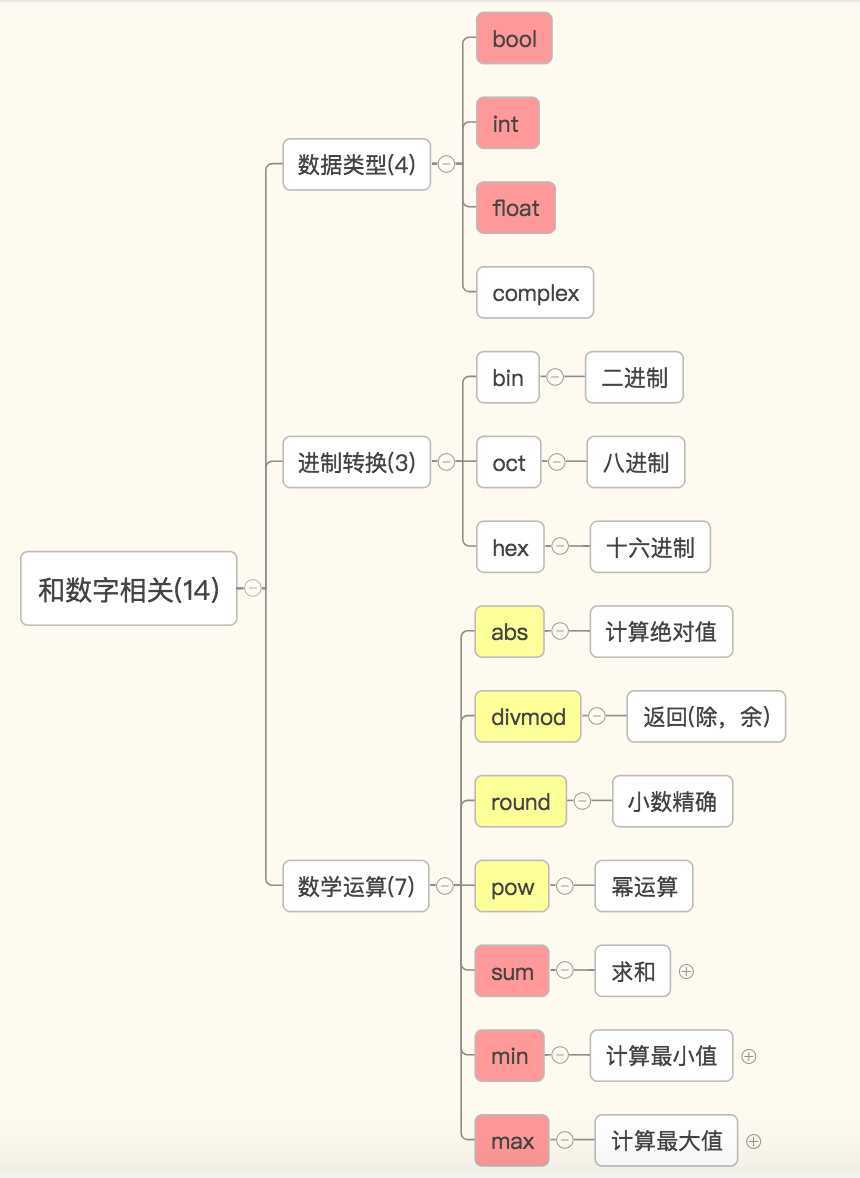
数字——数据类型相关:bool(布尔类型),int(数值类型),float(浮点型),complex(复数)
复数——complex
实数:有理数
无理数--不限不循环数,比如π
虚数:虚无缥缈的数 虚数以J为单位
flomat = 浮点数(有限循环小数、无限循环小数)!==小数 :无限不循环小数
数字——进制转换相关:bin(二进制),oct(八进制),hex(十六进制)
print(bin(3243)) #结果: 0b110010101011
print(oct(3243)) #结果: 0o6253
print(hex(3243)) #结果: 0xcab
数字——数学运算:abs(绝对值),divmod(除余),min(最小值),max(最大值),sum(求和),round(保留几位小数,四舍五入),pow(幂次方)
abs
print(-abs(434)) # -434
print(-abs(-434)) # -434
print(abs(434)) # 434
print(abs(-434)) # 434
divmod
print(divmod(9,2))
# 结果:(4, 1)
min
print(min(9,2,key=none)) key后面跟的是可调用对象
结果:2
max
print(max(9,2,key=none))
# 结果:9
sum(可迭代的数据)
print(sum([9,2,65]))
# 结果:76
round
print(round(34.3434,2))
#结果:34.43
pow
print(pow(3,3))
#结果:27
和数据结果相关
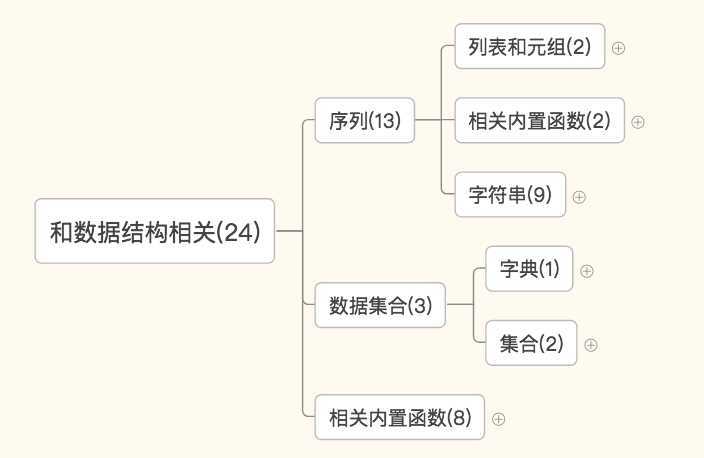
序列——列表和元组相关的:list和tuple
序列——字符串相关的:str,format,bytes,bytearry,memoryview,ord,chr,ascii,repr
内置函数format
说明:
1. 函数功能将一个数值进行格式化显示。
2. 如果参数format_spec未提供,则和调用str(value)效果相同,转换成字符串格式化。
print(format(32.35353), type(format(32.35353))) # 32.35353 <class ‘str‘>
print(str(32.35353), type(str(32.35353))) # 32.35353 <class ‘str‘>
3. 对于不同的类型,参数format_spec可提供的值都不一样
ret = bytearray(‘alex‘,encoding=‘utf-8‘)
print(ret) # bytearray(b‘alex‘)
print(id(ret)) # 14402816
print(ret[0]) # 97
ret[0] = 65
print(ret) # bytearray(b‘Alex‘)
print(id(ret)) # 14402816
memoryview
ret = memoryview(bytes(‘你好‘,encoding=‘utf-8‘))
print(ret) # <memory at 0x00D7F328>
print(len(ret)) # 6
print(bytes(ret[:3]).decode(‘utf-8‘)) #你
print(bytes(ret[3:]).decode(‘utf-8‘)) #好
序列:reversed,
l = (1,2,23,213,5612,342,43)
print(l) #(1, 2, 23, 213, 5612, 342, 43)
print(reversed(l)) # 得到一个翻转生成器
print(list(reversed(l))) #使用List强制取数,数据是翻转过来的的
生成一个切片规则:slice
l = (1,2,23,213,5612,342,43)
sli = slice(1, 5, 2)
print(l[sli])
#(2,213)
数据集合——字典和集合:dict
dict={key:values}
set(集合)
认识集合
由一个或多个确定的元素所构成的整体叫做集合。
集合中的元素有三个特征:
1.确定性(集合中的元素必须是确定的)
2.互异性(集合中的元素互不相同。例如:集合A={1,a},则a不能等于1)
3.无序性(集合中的元素没有先后之分),如集合{3,4,5}和{3,5,4}算作同一个集合。
*集合概念存在的目的是将不同的值存放到一起,不同的集合间用来做关系运算,无需纠结于集合中某个值
合
集合的定义
st = {1,‘ere‘,3,5}
#定义可变集合
set_test=set(‘hello‘)
print(set_test)
# {‘e‘, ‘l‘, ‘o‘, ‘h‘}
#改为不可变集合frozenset
set_test=set(‘hello‘)
f_set_test=frozenset(set_test)
print(f_set_test)
#结果 frozenset({‘e‘, ‘l‘, ‘h‘, ‘o‘})
集合的常用操作及关系运算
元素的增加
单个元素的增加 : add(),add的作用类似列表中的append
对序列的增加 : update(),而update类似extend方法,update方法可以支持同时传入多个参数
a={1,2}
a.update([1,2],[1,3,45]) # 增加的内容是可迭代的,类似extend方法
print(a)
# {1, 2, 3, 45}
a.update(‘hello‘)
print(a)
# {1, 2, 3, ‘l‘, 45, ‘h‘, ‘o‘, ‘e‘}
a.add(69) # 只能添加一个参数,类似类表达append
print(a)
# {‘h‘, 1, 2, 3, ‘o‘, 69, ‘e‘, 45, ‘l‘}
元素的删除
集合删除单个元素有两种方法:
元素不在原集合中时
set.discard(x)不会抛出异常
set.remove(x)会抛出KeyError错误
a = {‘h‘, 1, 2, 3, ‘o‘, 69, ‘e‘, 45, ‘l‘}
a.discard(1)
print(a)
# {2, 3, 69, ‘l‘, ‘h‘, 45, ‘o‘, ‘e‘}
a.remove(‘k‘) # 不存在改值是会报KeyError
print(a)
pop():由于集合是无序的,pop返回的结果不能确定,且当集合为空时调用pop会抛出KeyError错误,clear():清空集合
a = {‘h‘, 1, 2, 3, ‘o‘, 69, ‘e‘, 45, ‘l‘}
# a.pop()
# print(a)
# {2, 3, 69, ‘e‘, 45, ‘o‘, ‘l‘, ‘h‘}
a.pop()
print(a)
# {2, 3, 69, ‘e‘, ‘o‘, 45, ‘h‘, ‘l‘}
a.clear()
print(a)
a.pop() # 当集合为空时会报错KeyError: ‘pop from an empty set‘
集合操作
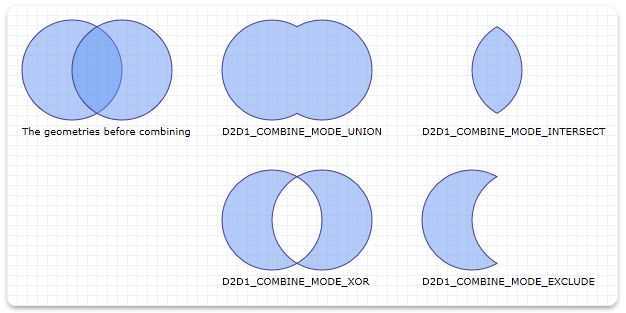
union,|=:合集 两种写法union |
a = {1,2,3}
b = {2,3,4,5}
print(a.union(b))
print(a|b)
结果为:{1, 2, 3, 4, 5}
&.&=:交集 两种写法 intersection &
a = {1,2,3}
b = {2,3,4,5}
print(a.intersection(b))
print(a&b)
结果为:{2, 3}
-,-=:差集 两种写法 difference -
a = {1,2,3}
b = {2,3,4,5}
print(a.difference(b))
print(a-b)
结果为:{1}
#^,^=:对称差集 两种写法symmetric_difference ^
a = {1,2,3}
b = {2,3,4,5}
print(a.symmetric_difference(b))
print(a^b)
# {1, 4, 5}
包含关系
in,not in:判断某元素是否在集合内
==,!=:判断两个集合是否相等
两个集合之间一般有三种关系,相交、包含、不相交。在Python中分别用下面的方法判断:
s = {1}
d = {2}
print(s.isdisjoint(d)) # True
s = {2}
d = {2}
print(s.isdisjoint(d)) # False
s = {2,‘fff‘,‘efefe‘}
d = {2,‘fff‘}
print(s.issuperset(d)) # True 相当于s集合里面的元素是否已经包含了集合d里面的所以元素
s = {2,‘fff‘}
d = {2,‘fff‘,‘efefe‘}
print(s.issubset(d)) # True 与上面反之相当于d集合里面的元素是否已经包含了集合s里面的所以元素
集合的工厂函数

class set(object): """ set() -> new empty set object set(iterable) -> new set object Build an unordered collection of unique elements. """ def add(self, *args, **kwargs): # real signature unknown """ Add an element to a set. This has no effect if the element is already present. """ pass def clear(self, *args, **kwargs): # real signature unknown """ Remove all elements from this set. """ pass def copy(self, *args, **kwargs): # real signature unknown """ Return a shallow copy of a set. """ pass def difference(self, *args, **kwargs): # real signature unknown """ 相当于s1-s2 Return the difference of two or more sets as a new set. (i.e. all elements that are in this set but not the others.) """ pass def difference_update(self, *args, **kwargs): # real signature unknown """ Remove all elements of another set from this set. """ pass def discard(self, *args, **kwargs): # real signature unknown """ 与remove功能相同,删除元素不存在时不会抛出异常 Remove an element from a set if it is a member. If the element is not a member, do nothing. """ pass def intersection(self, *args, **kwargs): # real signature unknown """ 相当于s1&s2 Return the intersection of two sets as a new set. (i.e. all elements that are in both sets.) """ pass def intersection_update(self, *args, **kwargs): # real signature unknown """ Update a set with the intersection of itself and another. """ pass def isdisjoint(self, *args, **kwargs): # real signature unknown """ Return True if two sets have a null intersection. """ pass def issubset(self, *args, **kwargs): # real signature unknown """ 相当于s1<=s2 Report whether another set contains this set. """ pass def issuperset(self, *args, **kwargs): # real signature unknown """ 相当于s1>=s2 Report whether this set contains another set. """ pass def pop(self, *args, **kwargs): # real signature unknown """ Remove and return an arbitrary set element. Raises KeyError if the set is empty. """ pass def remove(self, *args, **kwargs): # real signature unknown """ Remove an element from a set; it must be a member. If the element is not a member, raise a KeyError. """ pass def symmetric_difference(self, *args, **kwargs): # real signature unknown """ 相当于s1^s2 Return the symmetric difference of two sets as a new set. (i.e. all elements that are in exactly one of the sets.) """ pass def symmetric_difference_update(self, *args, **kwargs): # real signature unknown """ Update a set with the symmetric difference of itself and another. """ pass def union(self, *args, **kwargs): # real signature unknown """ 相当于s1|s2 Return the union of sets as a new set. (i.e. all elements that are in either set.) """ pass def update(self, *args, **kwargs): # real signature unknown """ Update a set with the union of itself and others. """ pass def __and__(self, *args, **kwargs): # real signature unknown """ Return self&value. """ pass def __contains__(self, y): # real signature unknown; restored from __doc__ """ x.__contains__(y) <==> y in x. """ pass def __eq__(self, *args, **kwargs): # real signature unknown """ Return self==value. """ pass def __getattribute__(self, *args, **kwargs): # real signature unknown """ Return getattr(self, name). """ pass def __ge__(self, *args, **kwargs): # real signature unknown """ Return self>=value. """ pass def __gt__(self, *args, **kwargs): # real signature unknown """ Return self>value. """ pass def __iand__(self, *args, **kwargs): # real signature unknown """ Return self&=value. """ pass def __init__(self, seq=()): # known special case of set.__init__ """ set() -> new empty set object set(iterable) -> new set object Build an unordered collection of unique elements. # (copied from class doc) """ pass def __ior__(self, *args, **kwargs): # real signature unknown """ Return self|=value. """ pass def __isub__(self, *args, **kwargs): # real signature unknown """ Return self-=value. """ pass def __iter__(self, *args, **kwargs): # real signature unknown """ Implement iter(self). """ pass def __ixor__(self, *args, **kwargs): # real signature unknown """ Return self^=value. """ pass def __len__(self, *args, **kwargs): # real signature unknown """ Return len(self). """ pass def __le__(self, *args, **kwargs): # real signature unknown """ Return self<=value. """ pass def __lt__(self, *args, **kwargs): # real signature unknown """ Return self<value. """ pass @staticmethod # known case of __new__ def __new__(*args, **kwargs): # real signature unknown """ Create and return a new object. See help(type) for accurate signature. """ pass def __ne__(self, *args, **kwargs): # real signature unknown """ Return self!=value. """ pass def __or__(self, *args, **kwargs): # real signature unknown """ Return self|value. """ pass def __rand__(self, *args, **kwargs): # real signature unknown """ Return value&self. """ pass def __reduce__(self, *args, **kwargs): # real signature unknown """ Return state information for pickling. """ pass def __repr__(self, *args, **kwargs): # real signature unknown """ Return repr(self). """ pass def __ror__(self, *args, **kwargs): # real signature unknown """ Return value|self. """ pass def __rsub__(self, *args, **kwargs): # real signature unknown """ Return value-self. """ pass def __rxor__(self, *args, **kwargs): # real signature unknown """ Return value^self. """ pass def __sizeof__(self): # real signature unknown; restored from __doc__ """ S.__sizeof__() -> size of S in memory, in bytes """ pass def __sub__(self, *args, **kwargs): # real signature unknown """ Return self-value. """ pass def __xor__(self, *args, **kwargs): # real signature unknown """ Return self^value. """ pass __hash__ = None
数据集合:len,sorted,enumerate,all,any,zip,filter,map
len 长度
s = ‘egef‘
print(len(s)) # 4
sorted(参数,key=None,reverse=False) 排序,会生成一个新的值,原值的结果不会变,需要保留原值不变的情况下可以使用此函数
s = {1,4,3,26,4}
ret = sorted(s)
print(ret) # [1, 3, 4, 4, 26]
print(s) # [1, 4, 3, 26, 4]
对List、Dict进行排序,Python提供了两个方法
对给定的List L进行排序,
方法1.用List的成员函数sort进行排序,在本地进行排序,不返回副本
方法2.用built-in函数sorted进行排序(从2.4开始),返回副本,原始输入不变
--------------------------------sorted---------------------------------------
sorted(iterable, key=None, reverse=False)
Return a new list containing all items from the iterable in ascending order.
A custom key function can be supplied to customise the sort order, and the
reverse flag can be set to request the result in descending order.
------------------------------------------------------------------------------------------------------------------------
参数说明:
iterable:是可迭代类型;
key:传入一个函数名,函数的参数是可迭代类型中的每一项,根据函数的返回值大小排序;
reverse:排序规则. reverse = True 降序 或者 reverse = False 升序,有默认值。
返回值:有序列表
列表按照其中每一个值的绝对值排序
l1 = [1,3,5,-2,-4,-6]
l2 = sorted(l1,key=abs)
print(l1) # [1, 3, 5, -2, -4, -6]
print(l2) # [1, -2, 3, -4, 5, -6]
列表按照每一个元素的len排序
列表按照每个元素的长度进行排序
l = [[1,2],[3,4,5,6],(7,),‘123‘]
print(sorted(l,key=len),)
# [(7,), [1, 2], ‘123‘, [3, 4, 5, 6]]
enumerate(参数) 枚举 生成可迭代对象里,前面生成一个序列号
s = [‘re‘,‘kgo‘,‘fons‘,‘fefe‘]
for i in enumerate(s): #参数为可迭代对象
print(i)
(0, ‘re‘)
(1, ‘kgo‘)
(2, ‘fons‘)
(3, ‘fefe‘)
all(参数) # 参数为可迭代对象,检测对象中是否包含FALSE 如有一个返回True
s = [‘kf‘,‘fjeof‘,‘ ‘]
print(all(s)) # True
any(参数)检测参数中是否有True,如有一个为True就反之True
s = [‘fe‘,‘fjei‘,‘‘]
print(any(s)) # True
zip(参数1,参数2,。。) 参数为可迭代对象,把各个参数分别拉起来组成一个个元组,注意是对称拉
s1 = {2,2,4,5}
s2 = [‘ad‘,‘fef‘,‘ef‘]
ret = zip(s1,s2,‘fe‘,‘fe‘) # 得到一个可迭代对象
print(list(ret))#列表里面包含元组
# [(2, ‘ad‘, ‘f‘, ‘f‘), (4, ‘fef‘, ‘e‘, ‘e‘)]
for i in ret: # 这样得到的结果为元组
print(i)
(2, ‘ad‘, ‘f‘, ‘f‘)
(4, ‘fef‘, ‘e‘, ‘e‘)
filter
filter()函数接收一个函数 f 和一个list,这个函数 f 的作用是对每个元素进行判断,返回 True或 False,filter()根据判断结果自动过滤掉不符合条件的元素,返回由符合条件元素组成的新list
例如,要从一个list [1, 4, 6, 7, 9, 12, 17]中删除偶数,保留奇数,首先,要编写一个判断奇数的函数:
lis = [1, 4, 6, 7, 9, 12, 17]
def is_odd(x):
return x % 2 == 1
ret = filter(is_odd,lis) # 得到一个可迭代的
print(list(ret)) # [1, 7, 9, 17] #根据判断自动返回符合条件值,新成一个新的列表利用filter()
可以完成很多有用的功能,例如,删除 None 或者空字符串:
lis = [‘test‘, None, ‘‘, ‘str‘, ‘ ‘, ‘END‘]
def is_not_empty(s):
return s and len(s.strip()) > 0 # 返回True ,None转换为布尔值为FALSE
print(list(filter(is_not_empty,lis)))
注意: s.strip(rm) 删除 s 字符串中开头、结尾处的 rm 序列的字符。
当rm为空时,默认删除空白符(包括‘\n‘, ‘\r‘, ‘\t‘,‘\f‘, ‘ ‘),如下:
a = ‘\t\t123\r\n\f‘‘‘
print(a.strip())
# 123
请利用filter()过滤出1~100中平方根是整数的数,即结果应该是:
[1, 4, 9, 16, 25, 36, 49, 64, 81, 100]
方法:
import math
def is_sqr(x):
return math.sqrt(x) % 1 == 0
print(list(filter(is_sqr, range(1, 101))))
map
Python中的map函数应用于每一个可迭代的项,返回的是一个结果list。如果有其他的可迭代参数传进来,map函数则会把每一个参数都以相应的处理函数进行迭代处理。map()函数接收两个参数,一个是函数,一个是序列,map将传入的函数依次作用到序列的每个元素,并把结果作为新的list返回。返回的是一个可迭代对象
有一个list, L = [1,2,3,4,5,6,7,8],我们要将f(x)=x^2作用于这个list上,那么我们可以使用map函数处理
l = [1,2,3,4,5,6,7,8]
def pow2(x):
return pow(x,2)
ret = map(pow2, l) #如这里使用filter会原封不动把原值返回回来,不会进行计算
print(list(ret))
结果:[1, 4, 9, 16, 25, 36, 49, 64]
匿名函数
匿名函数:为了解决那些功能很简单的需求而设计的一句话函数
# 这段代码
def calc(n):
return n ** n #相对于 (10 * 10*10*10*10*10*10*10*10*10)
print(calc(10))
# 换成匿名函数
calc = lambda n: n ** n
print(calc(10))
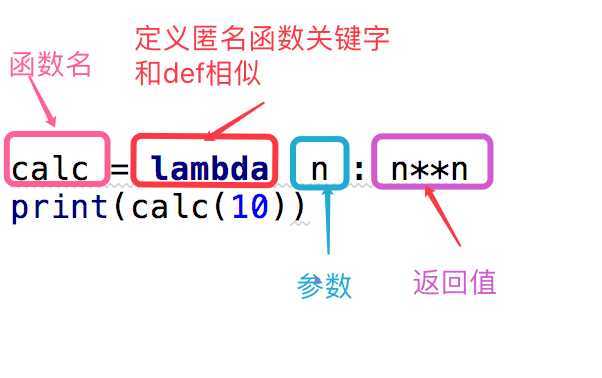
我们可以看出,匿名函数并不是真的不能有名字。
匿名函数的调用和正常的调用也没有什么分别。 就是 函数名(参数) 就可以了~~~
练一练:
请把以下函数变成匿名函数
def add(x,y):
return x+y
add = lambda x,y:x+y 改变为匿名函数的写法
print(add(9,10)) #19
上面是匿名函数的函数用法。除此之外,匿名函数也不是浪得虚名,它真的可以匿名。在和其他功能函数合作的时候
l=[3,2,100,999,213,1111,31121,333]
print(max(l))
# 求出最大值
dic={‘k1‘:10,‘k2‘:100,‘k3‘:30}
def func(key):
return dic[key]
print(max(dic,key=func)) # k2 这个要提前定义一个函数,key后面是传入字典中每个键,返回的是键对应的值,然后去最大值
print(max(dic,key=lambda k:dic[k])) # k2 匿名函数值需要些一行就可以了
print(dic[max(dic,key=lambda k:dic[k])]) # 100 去字典中最大的值
#lambda匿名函数写法
res = map(lambda x:x**2,[1,5,7,4,8])
for i in res:
print(i)
#正常函数写法
def res(x):
return pow(x,2)
ret = map(res,[1,5,7,4,8])
for i in ret:
print(i)
#匿名函数写法
res = filter(lambda x:x>10,[5,8,11,9,15])
for i in res:
print(i)
#正常函数写法
def res(x):
return x>10
ret = filter(res,[5,8,11,9,15])
for i in ret:
print(i)
面试题练一练
现有两个元组((‘a‘),(‘b‘)),((‘c‘),(‘d‘)),请使用python中匿名函数生成列表[{‘a‘:‘c‘},{‘b‘:‘d‘}]
1.匿名函数
#zip
ret = zip(((‘a‘),(‘b‘)),((‘c‘),(‘d‘)))
# def func(tup): #一般函数写法
# return {tup[0]:tup[1]}
# print(list(map(func,ret)))
# 匿名函数写法
print(list(map(lambda tup:{tup[0]:tup[1]} ,ret)))
2.下面打印的值是什么
d = lambda p:p*2
t = lambda p:p*3
x = 2
x = d(x) # 4
x = t(x) # 12
x = d(x) # 24
print (x) # 24
最后结果为:24
3.以下代码的输出是什么?请给出答案并解释。
def func():
return [lambda x:i*x for i in range(4)]
print([m(2) for m in func()]) # 其实不太明白lambda表达式不带名字时的调用方法
# [6, 6, 6, 6]
# 请修改multipliers的定义来产生期望的结果。
def func():
return (lambda x:i*x for i in range(4))
print([m(2) for m in func()])
# [0, 2, 4, 6]
本章小结
说学习内置函数,不如说整理自己的知识体系。其实整理这些内置函数的过程也是在整理自己的知识体系。
我们讲课的时候会归类:常用或者不常用,主要还是根据场景而言。
一个优秀的程序员就应该是在该用这个方法的时候信手拈来,把每一个内置的函数都用的恰到好处。
要想做到这一点,至少要先了解,才能在需要的时候想起,进而将它用在该用的地方。
但是在这里,我还是以自己的一点经验之谈,把几个平时工作中相对更常用的方法推荐一下,请务必重点掌握:
其他:input,print,type,hash,open,import,dir
str类型代码执行:eval,exec
数字:bool,int,float,abs,divmod,min,max,sum,round,pow
序列——列表和元组相关的:list和tuple
序列——字符串相关的:str,bytes,repr
序列:reversed,slice
数据集合——字典和集合:dict,set,frozenset
数据集合:len,sorted,enumerate,zip,filter,map
一下带key的5个函数,一般跟匿名函数搭配使用
min max filter map sorted
strip 替换是一个个字符进行替换的,不是整体进行替换的
原文:https://www.cnblogs.com/tinaLi/p/13290452.html